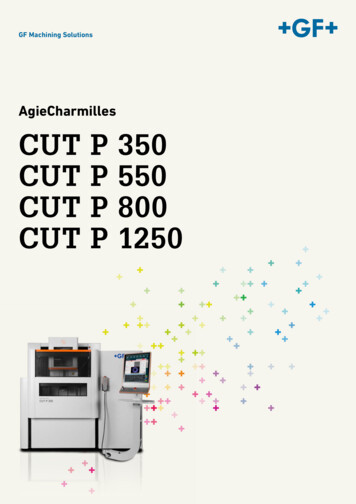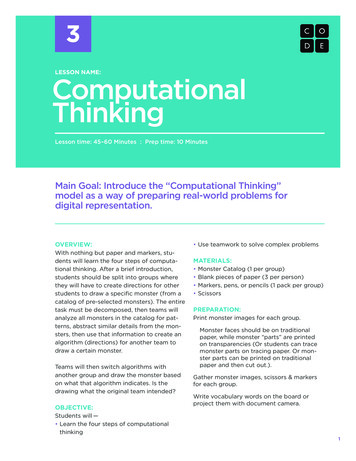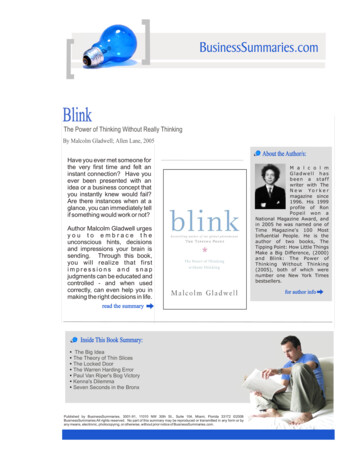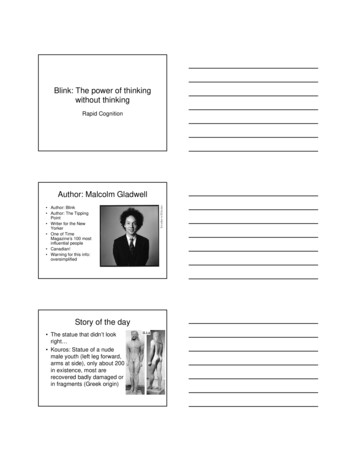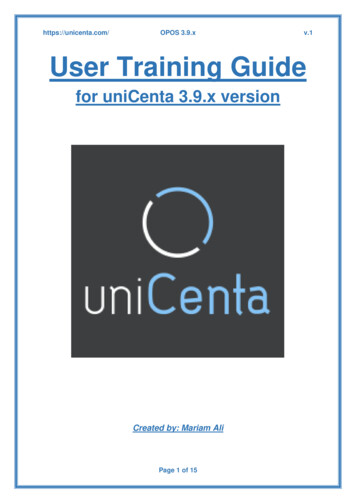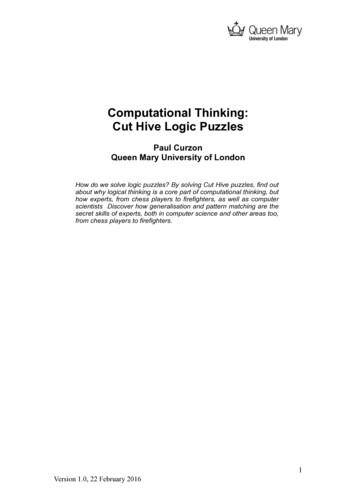
Transcription
!Computational Thinking:Cut Hive Logic PuzzlesPaul CurzonQueen Mary University of LondonHow do we solve logic puzzles? By solving Cut Hive puzzles, find outabout why logical thinking is a core part of computational thinking, buthow experts, from chess players to firefighters, as well as computerscientists Discover how generalisation and pattern matching are thesecret skills of experts, both in computer science and other areas too,from chess players to firefighters.!1Version 1.0, 22 February 2016
!Logic PuzzlesIf you enjoy logic puzzles and are good at them you will probably enjoy computerscience. Above anything else, being able to think logically is important to computerscientists. It runs through the whole subject but is especially important in writingprograms. Programs are founded on logic, and as we have already seen, thinkingclearly through all the possibilities is important for writing correct programs (andmagic tricks). They have to work under all circumstances, so when both writing themand evaluating them, the programmer has to sweat the detail.At one level when we talk about logical thinking we just about thinking clearly,chasing down the small details. However, there is a deeper meaning of working withmathematical logic, and if you can do that you will be much, much stronger atarguing cast iron cases. It is all about applying rules precisely. Arguments founded onlogic have no holes in them: something that the Ancient Greek Philosophers realisedwas an important skill. Being able to come up with solid arguments is usefulwhatever you do, not just for computer scientists. Logic puzzles are really aboutconstructing an argument, but cut down to the pure logic. Thinking logically is just askill like any other that can be learnt. It just takes practice and doing puzzles is a funway to develop it. It is as much as anything about attention to detail.Cut Up HivesYou’ve probably seen Sudoku: logic puzzles based on a grid of numbers. There are alot of different kinds of logic puzzles, and they all rely on the same ability to thinklogically. Let’s explore logical thinking using a simple kind of logic puzzle, called ‘CutHive’ puzzles. It is inspired by puzzles by Japanese puzzle inventor Naoki Inaba,called ‘Cut Blocks’.A Cut Hive puzzle consists of a block of hexagons, with different areas marked outusing thicker lines. There are two rules that must hold of a completed block.1) Each area must contain the numbers from 1 up to the number of hexagonsin the area. For example, the topmost area in the puzzle below consists of 4hexagons so those hexagons must be filled with the numbers: 1, 2, 3 and 4with no repeated numbers. If the area has two hexagons, like the one bottomleft below, then it must be filled with the numbers 1 and 2.2) No number can be next to the same number in any direction, along ashared edge. So in the grid below, the fact that there is a 4 in the middlemeans there cannot be a 4 in any of the 5 hexagons surrounding it.Overleaf is a simple Cut Hive Puzzle for you to solve. Try to complete it before youread on.!2Version 1.0, 22 February 2016
!242Solving a Cut HiveHere is the logical reasoning I used to complete the puzzle, based on the rules andthe numbers given. It is a cast iron argument that the filled out grid that I am claimingis a solution, really is a solution.At the bottom right of the grid is an area containing a single cell. That area has sizeone so must contain the numbers from 1 up to well 1. That means it must be 1 asbelow. Let’s fill it in :2421!3Version 1.0, 22 February 2016
!Next at the bottom left we have an area of two hexagons. It must contain thenumbers 1 and 2. One hexagon already has a number 2 in it, so the only possibilityleft for the other hexagon is 1.21421The remaining two areas are made of 4 hexagons each. We now have to be a bitcleverer than so far. Look at the 1 in the bottom corner. The fact that it is a 1 meansnone of the three hexagons round it can be a 1. However that area has only fourhexagons in it and one of them must be a 1. That means the last hexagon in the areathat isn’t next to the 1 must be the 1 because there isn’t any where else for it to go.We get the following hive.212411!4Version 1.0, 22 February 2016
!Next we can try and work out where the 2 goes in that same area. There is a 2 thattouches both the lower two hexagons, leaving the hexagon sandwiched between thetwo 1s down the right side as the only possibility for the 2.2142121There is also a 4 above that area and the new 4 can’t be next to it. It must be at thebottom. That determines which way round the 3 and 4 must be in the remaining twohexagons:212434121!5Version 1.0, 22 February 2016
!We are now left with the top area. We can fill it in using similar reasoning. The 1 inthe adjacent area means there is only one possible place for the last 1 to go in thetop left corner.1122434121That means the final hexagon is a 3 as that area must have numbers 1 to 4 and onlythe 3 is missing. The final solution is:11234342121We have solved the puzzle. We did it by applying the two rules and our basic facts ofwhich numbers were already known. From them we repeatedly worked out new factsabout our puzzle. We have been using a particular kind of logical reasoning called‘deduction’ where we work from known facts and the rules of the puzzle to give usnew facts. It is essentially the way Sherlock Holmes works his detective miracles. He!6Version 1.0, 22 February 2016
!notices things about people and deduces new facts as a consequence from them.The more facts he learns the more he can then go on to deduce, ultimately allowinghim to solve crimes. Computer scientists and mathematicians use similar reasoning.Good programmers use exactly this kind of reasoning to convince themselves thattheir programs work, always.Matching Patterns, Creating RulesWhat we have just been doing is deducing facts directly from the two rules. As youdo more puzzles, and get more experience though you start to solve the puzzles in adifferent way. You start to use some of your natural computational thinking skills:pattern matching against situations you have seen before, for example. That will letyou solve puzzles faster with less thought. It will also allow you to do generalisation,widening the situations you pattern match against. You will, with experience, start tocreate some new quicker and very general rules to use. You can then do logicalreasoning at a higher level, based on these more powerful rules. This is possiblebecause of using logical thinking, not to solve a puzzle, but to create the new rules.That way you are still sure that they are guaranteed to follow from the basic ones.Let’s see how.The Single Hexagon RuleGoing back to the way we solved the puzzle above, we worked out that when wehave an area consisting of a single hexagon, it must contain the number 1. Havingrealised that, we don’t have to think it through again, we can just treat it as a new rulethat follows from the original.3) IF an area has only one hexagon, THEN that hexagon holds the number 1.We can draw a diagram to represent the rule, rather than just use words. We use anarrow to show the change we make to the grid. On the left hand side we draw theposition we pattern match against and on the right hand side what we would changethat to.1Rules like this are called ‘production rules’ or ‘rewrite rules’. This diagrammatic rulesays that if we find an empty area of size one then we can transform it to a hexagonwith 1 in it.We can now just apply this rule directly without ever thinking about why it holds. Ourlogical thinking can now work at a higher level at least in this case!7Version 1.0, 22 February 2016
!The Two Hexagon RuleWe can create another new rule for areas consisting of two hexagons. We saw that ifwe have an area of size two, with one hexagon filled with a 2 then the other hexagonmust be 1.122Notice we can treat this as a generalised rule from the actual example in our puzzle.It doesn’t matter which hexagon holds the 2, the same logic applies. Our pictureapplies upside down too! It also can be applied if the hexagons are linked diagonallyin any direction as well.We can generalise the rule further though. By the same reasoning, if an area of size2 has a 1 already placed then the other hexagon must be 2.211Combining these two facts gives us the full generalised rule:4) IF a hexagon in an area of size two holds a 1 or a 2 THEN the otherhexagon holds the other number.We can give it as a diagram if we use a letter x to represent any number (just asmathematicians use x and y as variables in algebra). An x can stand for 1 one timewe use the rule, and as a 2 another time, as long as it doesn’t change in the middleof any particular time we apply it. A diagram of the rule is given below. We use x̅ inthe diagram to mean the other number that the x isn’t this time. So if x is 1 then x̅ is2, and if x is 2 then x̅ is 1. This rule can match an area of size 2 rotated in any wayand so whichever way round the two numbers are. This diagram turns in to our!8Version 1.0, 22 February 2016
!original rules (and their diagrams) just by setting x to 1 or 2. We are starting to inventa mathematical-like notation for the same reason mathematicians use symbols. Itgives us a precise way to talk about things, and as our rules become morecomplicated that is important if we aren’t going to make mistakes.x‾xxRather than deducing facts from given facts using the rules, we are now deducingnew rules that hold given the original rules. These are called ‘derived inference rules’.Whenever we see a situation that matches the pattern of one of our new rules, wedon’t have to think any more, we can just apply the rule.The Corner RuleLet’s look at a final example of creating a bigger rule from our solution to the simplecut hive puzzle that turns out to be quite useful. In the bottom right corner, we wereable to deduce where the next 1 in the area of four hexagons should go. It waspossible because there was already a 1 in the adjacent area, nestled into a corner asbelow.dcba1!9Version 1.0, 22 February 2016
!There must be a 1 in position a, b, c or d. However, there can’t be a 1 next to another1. That rules out positions a, b and c. The 1 must be in position d as it is all that isleft. We can draw that step as a rewrite rule diagram.111Of course any of the hexagons shown as blank could already be filled with othernumbers and the rule will still apply: that is another way of generalising our new rule.Also, as before, the number we are pattern matching against doesn’t have to be a 1.It could be any number formed as part of a bigger area. If we use a letter x again torepresent any number then our rule becomes the generalised version below.xxxWe can even generalise our rule in a further way too. The area we are filling doesn’thave to be exactly that shape. The extra hexagon could be in any of positions roundthe far edge of the bigger area: anywhere that is connected but doesn’t touch thecorner hexagon. In the version of the corner rule below we’ve used question marks toact as variables that show the possible positions of the hexagon of interest.Written in english we get a generalised rule:5) IF a hexagon is surrounded by an area of size four, with only three of thefour hexagons touching it THEN the fourth hexagon holds the same numberas the surrounded hexagon.!10Version 1.0, 22 February 2016
!?x?x?x?As before, the rule will apply upside down or on its side, rotated or reflected. Perhapsyou can think of even more ways to generalise the rule.Equipped now with this very general rule, if you find any situation that you canpattern match it against in a puzzle, then you can apply it. That means you can fill ina missing number, as indicated by whatever matches the x.Most people who do puzzles don’t bother to write down the rules they derive anduse. They just remember something that worked in the past and apply it when thechance arises without much thought. Computer Scientists like to write things like thatdown though. Why is it a good idea? Well, for one thing you can use them to teachother people how to do the puzzles without them having to work it all out forthemselves (as I just did for you). They can even be used to teach computers how todo the puzzles. It also makes things precise. It is easy to have a false recollection ofa rule that worked in the past, or for someone who has learnt it to misunderstand thedetail. In either case it could lead to the rule being applied incorrectly or applied it toa new situation that it doesn’t actually quite match. Writing a precise version downhelps avoid this kind of faulty reasoning.We are stretching the limits of what we can do with pictures now, though. In realitycomputer scientists tend to use mathematical notation (formal logics) to expressrules. These languages for expressing logic are a bit like programming languagesthough very flexible and have the big advantage that they can easily be processed bycomputers and so be the basis of computers doing this kind of reasoning. The logicbecomes the basis for computer programs that can solve the puzzles.Many Artificial Intelligence systems are based on this idea of programming using thiskind of production rule. Instead of drawing diagrams we write rules of the form IF some situation THEN action to do . A list of such rules makes up a program. If arule applies then the computer can do the action. This is done over and over again.We aren’t just using logical thinking as we become better and better at doing thepuzzles. We pattern match the rules against the current situation to know which toapply. A production rule program is doing the same kind of pattern matching. It isdoing some simple computational thinking. In writing the rules down to create that!11Version 1.0, 22 February 2016
!program, generalisation goes hand in hand with abstraction: we are hiding detailabout other parts of the puzzle to ma
Cut Hive Logic Puzzles Paul Curzon Queen Mary University of London How do we solve logic puzzles? By solving Cut Hive puzzles, find out about why logical thinking is a core part of computational thinking, but how experts, from chess players to firefighters, as well as computer scientists Discover how generalisation and pattern matching are the secret skills of experts, both in computer science .File Size: 418KBPage Count: 17
